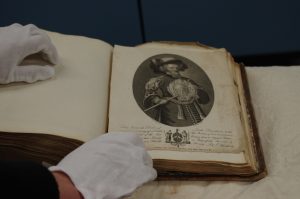Parisian Past-Times: Chronologie Collée and the Leeds Album
As part of the Cultural Collections Projects Program, I have been given the opportunity to catalogue an album of 17th century French prints under the guidance of prints curator Kerrianne Stone. We know from a letter by Dr J. Orde Poynton that in the early 1970s a collection of nine albums comprising approximately 8,000 engraved portraits (with French, German and Italian origination) was purchased by the University of Melbourne from Dawson’s of Pall Mall, London. The Leeds Album may have been related to this purchase but without acquisition records available we cannot be certain. Although the exact provenance of the album has been difficult to determine, I have uncovered some interesting information in the process of cataloguing the prints.
Bound in embossed leather, the Leeds Album is an impressive collection of over 245 engraved 17th century portraits which have been pasted onto the pages of the album. The subjects of the portraits include a range of eminent European individuals – mostly French – from the late middle ages to early modern period including kings and queens, Holy Roman Emperors, notable members of the clergy, politicians, classical philosophers and a lone hermit. Contained in the album are the works of several prominent engravers, including Pierre Daret, Balthasar Moncornet, Louis Boissevin, and Pieter de Jode II. The portraits are stylistically diverse and demonstrate the different technical abilities and decorative styles that were applied by the individual engravers and by the artists whom the engravers copied. Many of the portraits in the album are accompanied by text printed in French and Latin. These texts usually describe the subject’s status, title and historical significance. The album is marked throughout with handwritten annotations, poetry and hand-coloured engravings, suggesting that the album was a highly utilised and valued object.
A bookplate bearing the Leeds coat of arms, and a portrait within the album, adorned with a personalised dedication to the Duke of Leeds, reveals that the album was formerly in the possession of Francis Osborne (1751-1799), British politician and the 5th Duke of Leeds. It is likely that he was given the album as a gift when he was appointed to the post of ambassador of England to France in 1783.[1.] Osborne declined the position, however, and subsequently served as foreign secretary under William Pitt’s administration instead. [2.] Osborne began auctioning off his collection of Italian, French, Flemish and Dutch art at Pall Mall, London, in 1796. [3.] The Leeds Album may have been included in this sale.
Sections of the album feature engravings taken from Chronologie Collée series. Chronologie Collée was a French printmaking phenomenon that involved a series of small portraits of influential figures, printed in tabular format, which could be cut down to individual portraits and pasted into an album. [4.] This technique was popular in France, and, from the 1620s, there were at least twenty series of portraits, as well as sheets of biographical text and decorative borders, stocked by various print sellers around Paris. [5.] The aim of the format is similar to that of contemporary card collecting or scrapbooking; an individual could collect complete sets, assemble their albums themselves and create volumes. The Leeds Album features engravings from at least three different Chronologie Collée series: Rulers and Dukes of Brabant, Foresters and the Counts of Flanders and the Portraits of the many illustrious men who have flourished in France. Many of the engravings in the album were not printed in a tabular format but as individual portrait prints; these have also been trimmed and pasted into the album in a manner that is consistent with the Chronologie Collée technique.
It is likely that the intended purpose of the album was to provide Osborne with a reference book of important figures in French history, in order to prepare him for his position as English ambassador to France. This suggests that Chronologie Collées had a didactic element, as well as providing a leisurely activity. Throughout the album there are sections of consecutive blank pages, which suggests that these sections may have been purposefully left blank for future additions. Whether Osborne assembled the album himself, and what his methodical approach was, is unknown, but the question presents an interesting avenue for further research.
Once the album has been accessioned it will be available online via the EMu (Electronic Museum) database for further research and engagement. The French Album offers a glimpse into collecting practices, and diplomatic relations, of 17th century France. The Chronologie Collée printmaking technique is an intriguing and under-researched format, and, as such, the French album is an exciting and illuminating source to be housed in the university’s cultural collections.
Rosalie Mickan, Catalogue Assistant
Notes
[1.] Upon being offered the position of English ambassador to France, Osborne was gifted an album containing an exhaustive list of French knights and commandments and their coats of arms, it is likely that he was also gifted the Leeds album around this time. Sotheby’s, ‘Catalog of Knights, Commanders and Officers of the Order of the Holy Spirit,’ Auctions, Lot 38, 2009, Accessed 31 July 2017.
References
1 David Wilkinson ‘Osborne, Francis, fifth duke of Leeds (1751–1799)’, Oxford Dictionary of National Biography, Oxford University Press, online edn, Jan 2008, accessed 31 July 2017.
[3.] The Getty Research Institute, ‘Sale Catalog Br-A2164’, The Getty Provenance Index Database, ac-cessed 31 July 2017.
[4.] Royal Collection UK, ‘ Louys le Simple 21 Duc de Brabant. Charles le Gros 22 Duc de Bra-bant. Othon 23 Duc de Brabant… ’ Collections, accessed 31 July 2017.
[5.] Online Computer Library Center World Catalogue, ‘Chronologie Collée’, notes, accessed 31 Jul 2017.





Leave a Reply